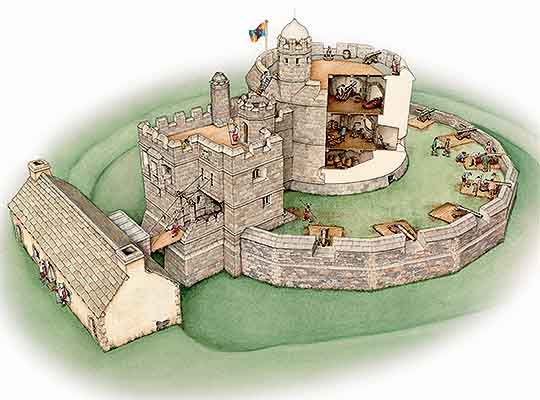Research on Pendennis Castle
Key to understanding the role and history of Pendennis as a coast fortress is the conservation plan published in 2000.[1] Archaeological investigation has generally been limited and opportunistic, leaving plenty of scope for further study and research-orientated investigation.

Research to date
A fine historical account of Pendennis Castle was published in 1875 by a serving officer of the garrison.[2] From 1921, when the castle was designated as a Scheduled Ancient Monument and taken into guardianship by the Office of Works,[3] research was carried out as the castle underwent a programme of repair and consolidation. This was confined to the Henrician gun tower, the general aim being to restore what was considered its general Tudor appearance. The rest of the castle was retained by the War Office on a care-and-maintenance basis.
A series of archaeological evaluations, watching briefs and excavations were carried out, mainly in the 1990s, on buildings and earthworks in and around the castle before works associated with public access and development.[4] These were followed by the detailed and systematic conservation plan, which brought together a wealth of primary and secondary sources and analysed the development of the fort and its buildings, both those still standing and those known only from archaeological investigation.[5]
The conservation plan also included detailed work on the analysis of the Falmouth defences as a whole, and as such is essential in understanding Pendennis's place at the heart of the overall defensive schemes from the 1530s until 1956. It is the most definitive statement available on the history and development of Pendennis Castle.
Subjects for future research
Henry VIII’s Artillery Fort
Some aspects of the Henrician castle remain unresolved:
- Are Little Dennis and the main castle of different dates or is Little Dennis an additional, sea-level gun battery contemporary with the castle?
- At what point was the chemise (gun platform) added to the main tower of the castle?
- Was the tower originally just a free-standing gun tower?
- At what date and for what reasons was the forebuilding constructed, replacing the original twin-towered gatehouse?
The Guard Barracks
The Guard Barracks are regarded as a very early Ordnance Office venture in barrack building of about 1700, but:
- When precisely were they built?
- What was their original configuration?
- Who had the ambition to embellish the nearby entrance with a classical pediment?
Records of the Ordnance Office
A thorough examination of the records of the Ordnance Office in the National Archives (class WO) would provide detailed information on the construction of many buildings and structures, as well as on the engineers, gunners, storekeepers and soldiers who lived at Pendennis, particularly in the period after the Restoration of 1660 until the 1850s.
Archaeological Investigation at Pendennis
Archaeological investigation/excavation would be required to recover and understand details of many known or vanished features of the fort interior and whole promontory, including:
- garrison buildings around and on the parade ground, about many of which knowledge is limited
- a possible prehistoric promontory fort
- Elizabethan and 17th-century outworks and siege works
- defences and trenches of both world wars.
READ MORE ABOUT PENDENNIS CASTLE
Footnotes
1. R Linzey, Fortress Falmouth: A Conservation Plan for the Historic Defences of Falmouth Haven, 2 vols (London, 2000).
2. S Pasfield Oliver, Pendennis and St Mawes: An Historical Sketch of Two Cornish Castles (Truro and London, 1875).
3. The National Archives, WORK 14/420 (Pendennis Castle, Falmouth, Cornwall, transfer from the War Office, 1920–23).
4. These are fully referenced in Linzey, op cit, 289–91.
5. Linzey, op cit.